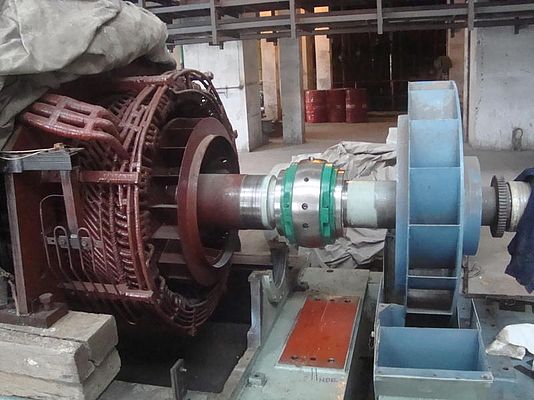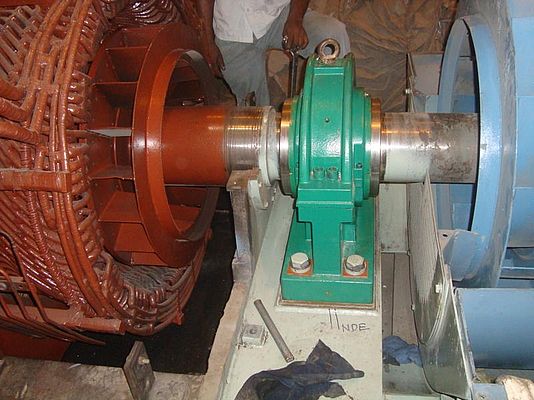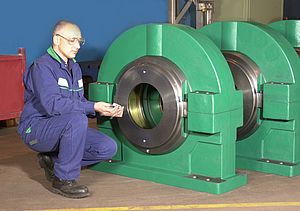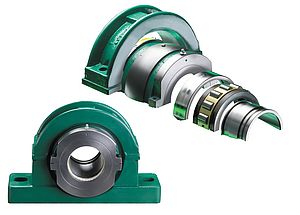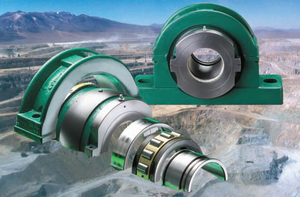The abrasive dust which is ever present in cement production plants means that bearing life is notoriously in this industry. Split roller bearing offer a long-life low maintenance solution.
Century Cement is part of the BK Birla Group of Companies, a leading Indian conglomerate. The plant is located in Baikunth, in the Indian district of Raipur, and is capable of producing 2.1million tonnes of cement per annum. The company places a strong focus on plant efficiency so when it was discovered that OE white metal bearings on a 2000kW induction motor were regularly failing the company decided to look for an alternative solution.
Century Cement found that the total life cycle of the original equipment white metal bearings on its raw mill motor drives was becoming so poor, that it was willing to invest in completely new drive systems, if a lower maintenance more cost effective motor bearing solution could not be found. Fortunately Revolvo was able to offer a long-life low maintenance SRB split roller bearing solution.
A spokesman for Bhavesh Engineering Pvt Ltd, Revolvo’s distributor in India, comments: “During routine review of the mill motor drives Century Cement engineers noted that the white metal bearings used on the induction motors required high levels of maintenance, including pumped oil recirculation lubrication systems, and often suffered from premature failure. The regular downtime and subsequent cost of these failures meant that either a suitable replacement bearing was required or the entire drive system would have to be replaced."
Initially grease lubricated solid spherical roller bearings were considered; by utilising simple grease lubrication instead of oil recirculation systems, significant maintenance cost reductions can be realised. However Century Cement was concerned that in the event of a bearing failure the replacement cycle would still involve significant down time as the motor shaft would need to be decoupled from the raw mill transmission, and lifted to enable bearing replacement to take place.
Fortunately Revolvo was able to offer a long term low maintenance cost solution with their SRB split roller bearings, which offer the same grease lubricated benefits of solid roller bearings but reduced bearing replacement times by 90%.
Unlike solid bearings, SRB split roller bearings are totally split to the shaft; a design that both simplifies and expedites installation and significantly cuts downtime costs in comparison to replacing solid bearings of a similar size. SRB split bearings allow the shaft to be supported by the lower section of the bearing, whilst the upper section of the housing and bearing outer race can be removed, making bearing inspection fast & simple, without the need to disconnect drives or lift the shaft. This intrinsic feature is especially valuable regarding large rotating machines, where sheer weight and size can be a barrier to fast and effective servicing.
The spokesman for Bhavesh Engineering continues: “When we were approached to propose an alternative solution to Century Cement to replace the OE white metal bearings we were able to show that not only would SRB split roller bearings last longer and require lower maintenance resources, bearing replacement would be far quicker compared to other solutions on the market when the time did come for bearings to be changed.”
Since the SRB split roller bearings have been installed the application has run with far greater operation efficiency and economy. These original bearings have been so successful that Century Cement now specifies Revolvo’s SRB split bearings as their component of choice.
Speaking of the SRB bearings A. Patini, Executive President (Plant) of Century Cement, said: “...since the installation, we have been very satisfied with the performance of these units. Following the success of this project we will give consideration to the conversion of other applications within the plant as appropriate.”


